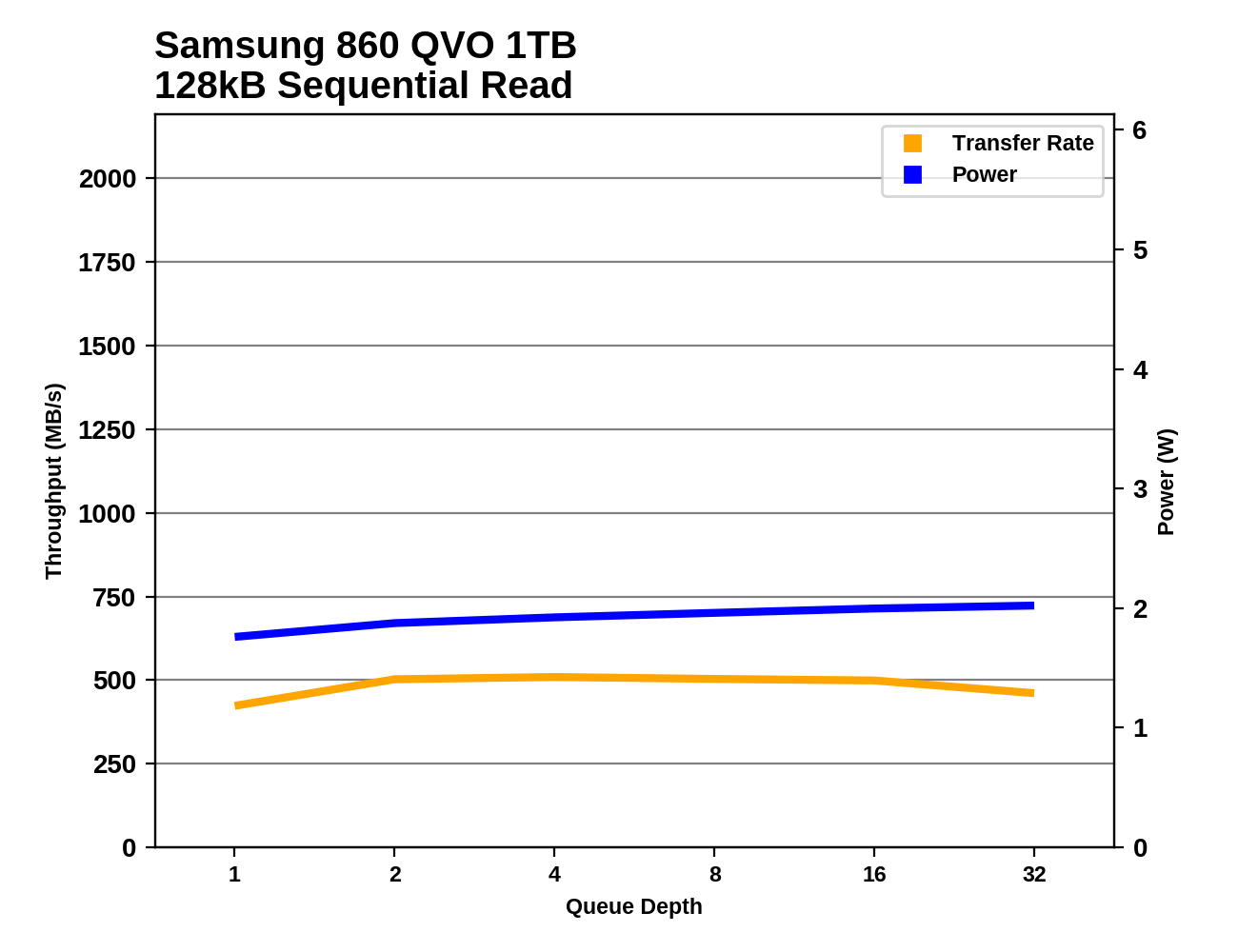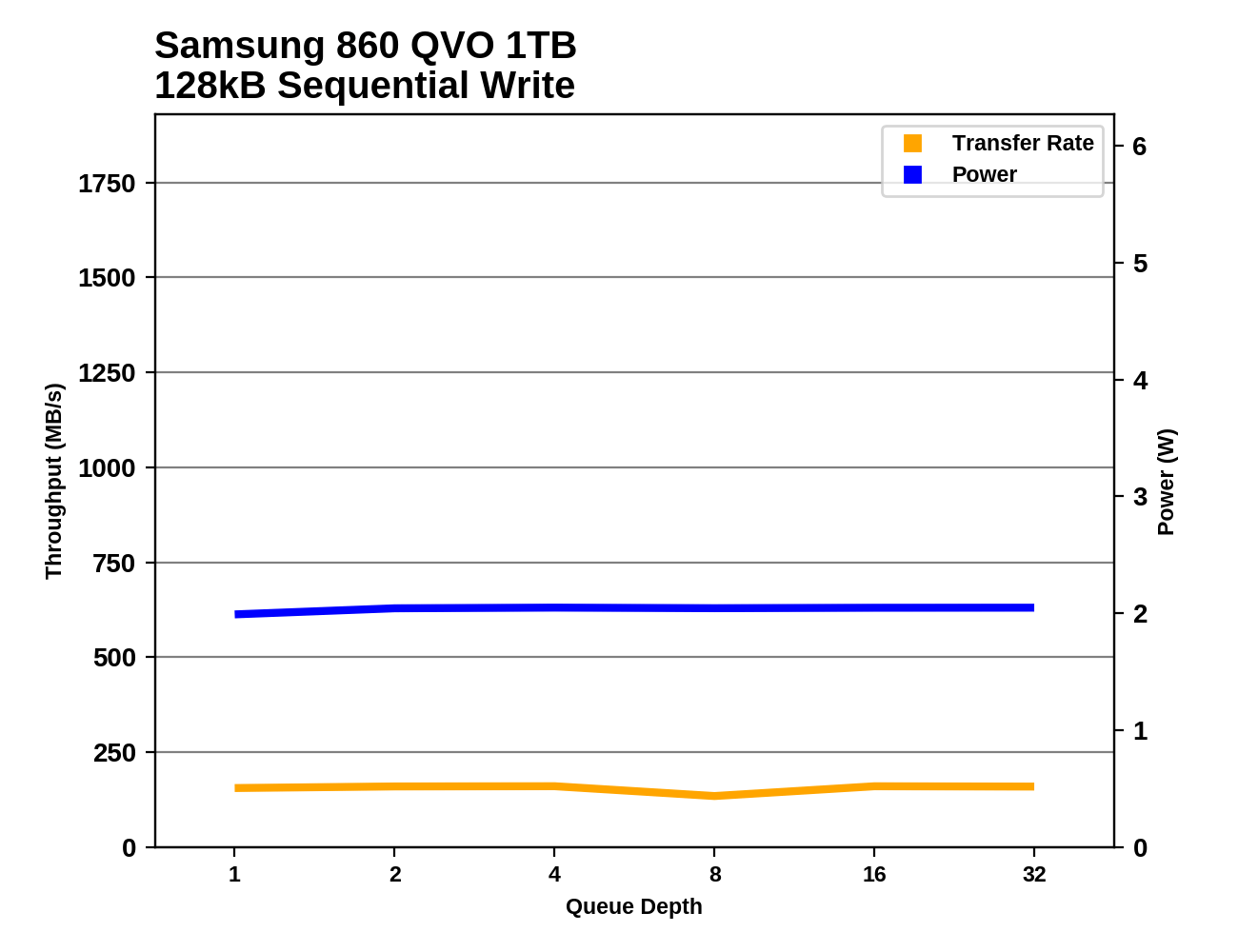The Samsung 860 QVO (1TB, 4TB) SSD Review: First Consumer SATA QLC
by Billy Tallis on November 27, 2018 11:20 AM ESTSequential Read Performance
Our first test of sequential read performance uses short bursts of 128MB, issued as 128kB operations with no queuing. The test averages performance across eight bursts for a total of 1GB of data transferred from a drive containing 16GB of data. Between each burst the drive is given enough idle time to keep the overall duty cycle at 20%.

The burst sequential read performance of the Samsung 860 QVO is generally competitive with mainstream TLC SATA SSDs and is well ahead of the DRAMless Toshiba TR200. The 1TB 860 QVO's score is a bit lower when the drive isn't full because of the timing of the tests: the drive was still flushing the SLC cache in the background when the read test started.
Our test of sustained sequential reads uses queue depths from 1 to 32, with the performance and power scores computed as the average of QD1, QD2 and QD4. Each queue depth is tested for up to one minute or 32GB transferred, from a drive containing 64GB of data. This test is run twice: once with the drive prepared by sequentially writing the test data, and again after the random write test has mixed things up, causing fragmentation inside the SSD that isn't visible to the OS. These two scores represent the two extremes of how the drive would perform under real-world usage, where wear leveling and modifications to some existing data will create some internal fragmentation that degrades performance, but usually not to the extent shown here.

On the longer sequential read test, the 860 QVO continues to get reasonably close to the SATA speed limit when reading data that is contiguous on the flash itself. Where internal fragmentation is caused by writing to the drive randomly, the QVO's read speed suffers much more than for the TLC drives, and the 1TB 860 QVO ends up slightly slower than a mechanical hard drive.
 |
|||||||||
| Power Efficiency in MB/s/W | Average Power in W | ||||||||
The power efficiency of the 860 QVO is only a little bit lower than the TLC drives for the contiguous data case. When dealing with fragmented data, the QVO is slightly more efficient than the Intel/Micron NVMe QLC drives despite being a bit slower.
 |
|||||||||
The queue depth scaling behavior for the 860 QVO is very typical, with QD1 not quite saturating the SATA link but all higher queue depths hitting close to full speed. The one exception is a slight decrease from the 1TB drive during the final QD32 phase.
Aside from the mild QD32 drop in performance, the sequential read behavior of the 860 QVO doesn't fall outside the normal ranges we've come to expect from TLC drives.
Sequential Write Performance
Our test of sequential write burst performance is structured identically to the sequential read burst performance test save for the direction of the data transfer. Each burst writes 128MB as 128kB operations issued at QD1, for a total of 1GB of data written to a drive containing 16GB of data.

The Samsung 860 QVO handles the burst sequential write test fine when the drive is mostly empty and there's plenty of room in the SLC cache. When the drive is full, the 1TB model's speed suffers somewhat, but is still much faster than the mechanical hard drive or the DRAMless TLC drive.
Our test of sustained sequential writes is structured identically to our sustained sequential read test, save for the direction of the data transfers. Queue depths range from 1 to 32 and each queue depth is tested for up to one minute or 32GB, followed by up to one minute of idle time for the drive to cool off and perform garbage collection. The test is confined to a 64GB span of the drive.

On the longer sequential write test, the SLC cache of the 1TB 860 QVO is not quite enough even when the drive is mostly empty, so it ends up in last place. The 4TB model's SLC cache keeps up with this test and it is as fast as any SATA drive.
 |
|||||||||
| Power Efficiency in MB/s/W | Average Power in W | ||||||||
The 860 QVO is a bit more power-hungry than the 860 EVO, so the 4TB QVO only takes third place for efficiency among the SATA drives in this bunch. The 1TB QVO has similar efficiency to the faster but more power-hungry 1TB QLC NVMe drives from Intel and Micron.
 |
|||||||||
The 1TB 860 QVO is mostly slow and steady during the sequential write test, while the 4TB model's performance is as good as any other SATA drive.
The 1TB 860 QVO's sequential write behavior sticks out clearly as far slower than typical, but it's not unprecedented: there have been TLC drives this slow, but most of them were much smaller than 1TB. The 4TB model blends in with the crowd much better.












109 Comments
View All Comments
boozed - Sunday, March 24, 2019 - link
RecoupedFunBunny2 - Tuesday, November 27, 2018 - link
"moving off of spinning rust and onto SSDs with my bulk storage. "well... cold storage of NAND ain't all that hot even at SLC. at QLC? not up to bulk storage, if you ask me. and, no, you didn't.
0ldman79 - Tuesday, November 27, 2018 - link
Bulk storage on the PC, not offline storage.I could use a big SSD myself, but at this price I'm better off picking up an EVO or WD 3D NAND instead.
I'm sure it will drop in a couple of months and we may even see the 1TB hit the $99 mark. Samsung QLC is looking pretty decent, overall endurance isn't much worse than my WD Blue 1TB 3D NAND, though smaller capacities drop off horribly.
azazel1024 - Friday, November 30, 2018 - link
What conditions? SLC lasts a LONGGGgggggg time powered off. Decades.MLC on a lightly used drive is also years and years. TLC is also measured in years on a lightly used drive under the right conditions.
Yes, an abused TLC drive today, left in a hot car in the summer time is going to start getting corrupt bits in a matter of a few weeks. That isn't most people's use case and for bulk storage, TLC at least kept vaguely room temperature has a storage life of something >1yr even when pushing up near the P/E endurance of the drive. I forget what JEDEC calls for (or whoever the standards body is), but the P/E endurance on TLC IIRC is 9 months at room temperature. IE your drive should typically not lose any stored bits when at room temperature and powered off for 9 months once you have exhausted your P/E endurance (obviously going past it reduces the powered off endurance as well as the potential for other things, like blocks not being able to be written to due to high power requirements or not being able to differentiate voltages, etc.)
I don't know what the endurance on QLC is supposed to be, but IIRC it is still measured in multiple months at the limit of P/E endurance (and typically when new the cold/off endurance of a drive is several times longer than when it is at the end of its life). I wouldn't want to use QLC, TLC or even MLC or SLC as archival storage that is supposed to last decades, but HDDs could be problematic for decadal storage also.
Araemo - Tuesday, November 27, 2018 - link
Honestly? Give me a 4TB for $300 and I start getting tempted. I have an array of 4 3TB spinning rust (5900 RPM even) disks I would love to upgrade to SSDs and at least a moderate size increase. I'd prefer 6TB or 8TB disks, so I can double the array size, but 4TB at a reasonable price gets tempting.Spunjji - Wednesday, November 28, 2018 - link
Wait. Just wait. Every time the capacity goes up and the price goes down, another poster comes along with a new higher capacity they want at a new lower price. You'll get it one day but right now it's physically impossible.rpg1966 - Wednesday, November 28, 2018 - link
Ha, I came here to say this. These guys would (supposedly) have jumped at these capacity/price/speed/endurance combinations a year ago, but now, oh no, they're way too expensive. It's a wonder they ever buy anything at all...azazel1024 - Friday, November 30, 2018 - link
My limit has always been spending $600-800 to replace the storage in my desktop and server. Right now I am utilizing 3.5TiB of the 5.4TiB capacity of my 2x3TB RAID0 arrays. Now that has been creeping up. 12 months ago it was probably 2.8-2.9TiB utilized. At any rate, I need enough performance (minimum 250MB/sec sustained large transfers once SLC cache is exhausted, or if below, it better be very close to that figure) to not need feel the need to make a RAID array so I can run JBOD and add disks as my storage pool gets utilized so they don't need to all be matching drives.4TB would maybe just barely cut it, but it also likely wouldn't leave me enough growth room as I'd be running out to add probably 2TB disks in a few months. 5-6TB would probably be enough to last me 18-24 months before I'd need to add any disks.
Anyway, so you are talking 10TB of total storage (minimum) for no more than about $800. My song hasn't changed on that in the last couple of years. We still aren't there. Though getting close. 8 cents a GB isn't THAT far away. And by the time we get there, my needs might have only creeped up to 12TB for the same no more than $800 (and who knows, maybe in a couple more years I could gin up another $100 or $200 to get it, even if prices haven't gotten down to 6-7 cents a GB).
So if I was looking at 3x2TB drives in JBOD and could just add another 2TB disk to it as my storage got filled up for a measly ~$350 between both machines every couple of years (and hopefully getting cheaper each time I did it, or it is cheaper enough when I need more capacity a couple years after building the SSD storage pools to get a new 4TB disk for each machine or something).
One of the things I don't like have HDDs and RAID (well it would be the same with SSDs and RAID) is really needing matching drives. So if my storage runs low, it means replacing entire arrays instead of just adding a new disk to provide the extra capacity, but being able to keep both higher performance and keeping a unified volume.
Right now my minimum HDD standard once I start hitting capacity/performance limits is probably going to be getting a set of Seagate Barracuda Pro drives for the performance of 7200rpm spindle speeds. That means 2x2x4TB drives (so 4 drives total) which is around $600 right now, and only gets me 1/3rd more capacity...
In other words I'd likely need to replace both arrays again maybe 3 years later (at most). Going to 2x2x6TB drives might make longer term financial sense, but it also has a startup cost of around $1000.
Impulses - Thursday, November 29, 2018 - link
It'll probably take several years for prices to get to that point... Optimistically.Spunjji - Wednesday, November 28, 2018 - link
"They are trying to milk saps"There's no evidence whatsoever for that claim. TLC drives weren't cheaper than MLC when they started out, now they (mostly) are - it's how product introductions work. The same will happen here. Enough of the bleating and moving of goalposts to ridiculous locations already.